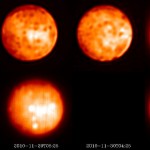Another try at improving my planetary technique. A bit better, notably because the raw material was shot from the summit where the seeing is much better. it was not a great night for Mauna Kea, but it was much better than Waikoloa…

When you want to see the stars, find someplace dark
W. M. Keck Observatory Press Release…
Three massive volcanic eruptions occurred on Jupiter’s moon Io within a two-week period, leading astronomers to speculate that these presumed rare “outbursts,” which can send material hundreds of miles above the surface, might be much more common than previously thought. The observations were made using the W. M. Keck Observatory and Gemini Observatory, both near the summit of Mauna Kea, Hawaii.

Io, the innermost of Jupiter’s four large “Galilean” moons, is about 2,300 miles across, and, aside from Earth, is the only known place in the solar system with volcanoes erupting extremely hot lava like that seen on Earth. Because of Io’s low gravity, large volcanic eruptions produce an umbrella of debris that rises high into space.
De Pater’s long-time colleague and coauthor Ashley Davies, a volcanologist with NASA’s Jet Propulsion Laboratory at the California Institute of Technology in Pasadena, Calif., said that the recent eruptions resemble past events that spewed tens of cubic miles of lava over hundreds of square miles in a short period of time.
“These new events are in a relatively rare class of eruptions on Io because of their size and astonishingly high thermal emission,” he said. “The amount of energy being emitted by these eruptions implies lava fountains gushing out of fissures at a very large volume per second, forming lava flows that quickly spread over the surface of Io.”
All three events, including the largest, most powerful eruption of the trio on 29 Aug. 2013, were likely characterized by “curtains of fire,” as lava blasted out of fissures perhaps several miles long.
Continue reading “Observations Reveal Massive Eruptions on Jupiter’s Moon Io”
W. M. Keck Observatory press release…
Watching active volcanic eruptions should be done from a safe distance, and a group of California researchers has figured out how to do it from, ironically, Mauna Kea – one of Earth’s tallest volcanoes – using the W. M. Keck Observatory. Employing an ingenious combination of telescopic surveys and archival data, they have gathered nearly 40 distinct snapshots of effusive (slow) volcanic eruptions and high temperature outbursts on Jupiter’s tiny moon, Io, showing details as small as 100 km (60 miles) on the moon’s surface.
While space-based telescopes were once required for viewing surface details on Io – similar in size to our Moon, but more than 1,600 times distant – adaptive optics (AO), pioneered at Keck, allows teams like that led by Franck Marchis, a researcher at the Carl Sagan Center of the SETI Institute, to collect fascinating data on the wild show from Earth. Marchis presented results from ground-based telescopic monitoring of Io’s volcanic activity over the past decade this week, at the 2012 Division of Planetary Sciences Meeting of the American Astronomical Society.
Erupting volcanoes on Io cannot be seen well from beneath the Earth’s atmosphere using classical astronomical techniques. Io is a relatively small satellite with a 3,600 km diameter, more than 630 million kilometers away. In 1979, Voyager 1 visited the Jovian system, revealing Io’s dynamic volcanic activity from the first close-up pictures of its surface, capturing bizarre volcanic terrains, active plumes and hot spots. The Galileo spacecraft remained in orbit in the Jovian system from 1995 to 2003 and observed more than 160 active volcanoes and a broad range of eruption styles. Several outstanding questions remained in the post-Galileo era, and the origin and long-term evolution of Io’s volcanic activity is still not fully understood.

In the meantime, astronomers designed instruments to break the “seeing barrier” and improve the image quality of ground-based telescopes. The blurring (“seeing”) introduced by the constant motion of the Earth’s atmosphere can be measured and corrected in real time using adaptive optics (AO), providing an image with a resolution close to the theoretical “diffraction limit” of the telescope. The W. M. Keck Observatory has used adaptive optics since 1999.
“Since our first observation of Io in 2001 using the Keck II 10-meter telescope and its AO system from Mauna Kea in Hawaii, our group became very excited about the technology. We also began using AO at the Very Large Telescope in Chile, and at the Gemini North telescope in Hawaii. The technology has improved over the years, and the image quality and usefulness of these AO systems have made them part of the essential instrument suite for large telescopes,” said Marchis.
Continue reading “Adaptive Optics Allows Earth-Based Monitoring of Io’s Fiery Show”